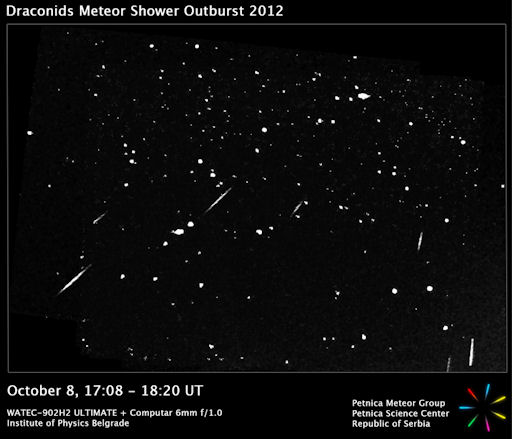ASTEROID FLYBY--TODAY: Newly-discovered asteroid 2012 TC4 will fly past Earth on Oct. 12th only 96,000 km (0.25 LD) away. There is no danger of a collision, but the 16 meter-wide space rock will be close enough to photograph through backyard telescopes as it brightens to approximately 14th magnitude. NASA hopes to ping this this object with radar, refining its orbit and possibly measuring its shape. Stay tuned for updates. [3D Orbit] [ephemeris] [more] [Images: #1, #2]
DRACONID METEOR OUTBURST: On Oct. 8th, more than 2000 meteors per hour exploded across the skies of North America and Europe. Radars in Canada and Germany detected the outburst of Draconids, yet sky watchers saw almost nothing. The meteors were too dim for human vision. Nevertheless, a meteor camera in Serbia captured visual evidence that an outburst was underway:
These seven Draconids appeared over the Petnica Science Center at the Institute of Physics in Belgrade. They were the bright "tip of the iceberg" marking the presence of an underlying stream of much dimmer and more numerous meteoroids. Researchers believe the outburst happened when Earth passed through a stream of dusty debris from Comet 21P/Giacobini-Zinner, parent of the annual Draconid meteor shower. This particular stream was laid down by the comet when it passed by Earth's orbit in 1959.
Realtime Space Weather Photo Gallery
SATISFACTORY LIGHTS: A coronal mass ejection hit Earth's magnetic field on Oct. 8th, sparking a dramatic display of Arctic lights that is only slowly subsiding three days later. Hugo Løhre photographed the auroras over Lekangsund, Norway, on Oct. 10th:
"I was testing my new Nikon digital camera when these auroras appeared," says Løhre. "I am satisfied."
More lights like these could appear on Oct. 14-15. That's when a stream of solar wind spewing from a hole in the suns atmosphere (a "coronal hole") is expected to reach Earth, possibly sparking geomagnetic storms when it arrives. Aurora alerts: text, voice.

![]()
Solar wind
speed: 493.9 km/sec
density: 0.0 protons/cm3
explanation | more data
Updated: Today at 1816 UT
![]()
X-ray Solar Flares
6-hr max: B8 1255 UT Oct12
24-hr: C9 0820 UT Oct12
explanation | more data
Updated: Today at: 1759 UT
![]()
![]()
![]()
Daily Sun: 12 Oct 12
![]()
![]()
Sunspot 1589 poses a threat for M-class solar flares. Credit: SDO/HMI
![]()
![]()
![]()
Sunspot number: 82
What is the sunspot number?
Updated 12 Oct 2012
Spotless Days
Current Stretch: 0 days
2012 total: 0 days (0%)
2011 total: 2 days (<1%)
2010 total: 51 days (14%)
2009 total: 260 days (71%)
Since 2004: 821 days
Typical Solar Min: 486 days
Update 12 Oct 2012
The Radio Sun
10.7 cm flux: 117 sfu
explanation | more data
Updated 12 Oct 2012
![]()
![]()
![]()
Current Auroral Oval:
![]()
Switch to: Europe, USA, New Zealand, Antarctica
Credit: NOAA/POES
![]()
![]()
![]()
Planetary K-index
Now: Kp= 3 quiet
24-hr max: Kp= 4 unsettled
explanation | more data
![]()
Interplanetary Mag. Field
Btotal: 7.3 nT
Bz: 0.2 nT south
explanation | more data
Updated: Today at 1816 UT
![]()
![]()
![]()
Coronal Holes: 12 Oct 12
![]()
![]()
Solar wind flowing from the indicated coronal hole should reach Earth on Oct. 14-15. Credit: SDO/AIA.






